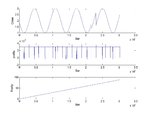danielfppps
Junior member
- Messages
- 21
- Likes
- 0
I discovered this like few years ago that random shuffling don't impact results
but i repeated this test to be sure so here they are. Trading time January 2014
21 trading days. As you can see no impact....so no real time series...
In 1st result line
groups = groups(randperm(N));
is commented out
Krzysztof
EURUSD SL15 TP30 RSI50 RBM20
ALGO RESULTS
Profit PP AC MC Kappa p PF WL
-500175.00 29.74 0.34 -0.32 -0.31 0.00 0.48 0.13
and after random shuffling
%Create batches
numbatches= ceil(N/batchsize);
groups= repmat(1:numbatches, 1, batchsize);
groups= groups(1:N);
groups = groups(randperm(N));
for i=1:numbatches
batchdata{i}= X(groups==i,🙂;
batchtargets{i}= targets(groups==i,🙂;
end
ALGO RESULTS
Profit PP AC MC Kappa p PF WL
-472372.00 29.40 0.34 -0.33 -0.31 0.00 0.48 0.12
Model building is clearly independent of shuffling. However the results on a testing set are dependent on whether the data used for the building of the modeling contains or does not contain future data. So I am not talking about shuffling of the data used to build the model but about the presence of future data inside the model relative to the data being predicted (data-snooping bias).






